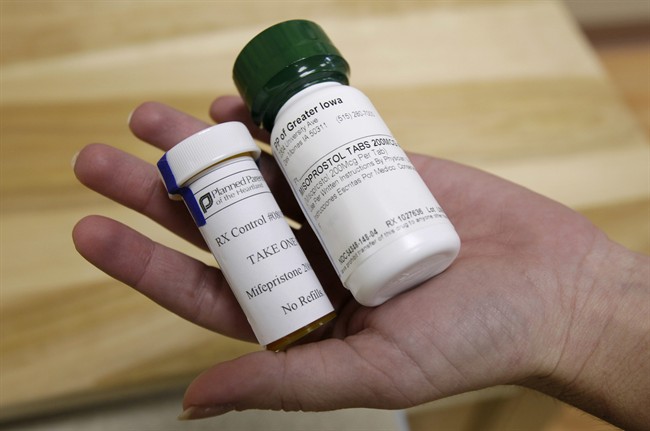One year after the abortion pill became available to Canadian women, new numbers show thousands have used the new option for reproductive health care and sexual health experts say they expect that number to keep rising.

Mifegymiso is the commercial name for a two-drug combination approved by Health Canada to be used to terminate early pregnancies up to nine weeks, which was approved in 2015 with tight restrictions but only became available to the public in January 2017.
READ MORE: How the ‘abortion pill’ Mifegymiso could change reproductive health
As CBC News first reported, new documents tabled in Parliament and obtained by Global News now show that the abortion pill was dispensed a total of 4,253 times last year despite those tight restrictions, which were only lifted in November 2017.
Only one adverse reaction — heavy bleeding — was reported.
WATCH BELOW: Health Canada approves pill as non-surgical abortion option for early pregnancy
Reproductive rights advocates had raised concerns about the restrictions on the drug.
Until November 2017, those included requiring prescribing doctors to take a training course and limiting its use up to seven weeks in a pregnancy.
READ MORE: Health Canada approves abortion pill use up to nine weeks
While advocates say there is still much work to be done to improve access to the drug, they told Global News they’re encouraged to see the demand for the medication among Canadian women seeking abortions.

Get daily National news
“It was really great to see that number,” said Frederique Chabot, director of health promotion for Action Canada for Sexual Health and Rights.
“Until the month of November, there were really strict requirements in terms of who could prescribe Mifegymiso, who could dispense it. There are now six provinces that have universal cost coverage but that wasn’t the case for 2017.”
READ MORE: Long-awaited abortion pill Mifegymiso makes Canadian debut
Each year in Canada, roughly 100,000 women terminate their pregnancies.
Just three per cent of those terminations are done using drugs but in 2017, Chabot said that appeared to rise to around four per cent given the number of prescriptions issued for the abortion pill.
The vast majority are surgical abortions performed in clinics or hospitals.
Ninety per cent are performed in the first trimester.
WATCH BELOW: Provinces offer universal coverage to women seeking abortion pill
Prior to the approval of Mifegymiso, medical abortions were sometimes available using a less effective combination of drugs, but the option was not readily available to women across the country or as successful as the combination currently approved.
In the United States, 20 per cent of abortions involve the same combination of drugs used in Mifegymiso.
That number is closer to 60 per cent in European countries like France, which first approved the drug 30 years ago.
READ MORE: Where in Canada can you get an abortion? It’s secret — for security reasons
Still, when the Canadian government approved the medication, it did so with a myriad restrictions not normally put in place in other countries.
It took roughly two years of outcry from advocates for the government to relent and relax the rules.
Doctors no longer need to take a training course specific to the drug and can prescribe it up to nine weeks into a pregnancy, which is in line with how it is regulated in other jurisdictions.
“The obstacles have been falling like dominoes over the last year but we still have a long way to go,” said Joyce Arthur, executive director of the Abortion Rights Coalition of Canada.
Saskatchewan, Manitoba, Newfoundland and the territories still do not include coverage of the drug under provincial health plans, meaning women who want a medical abortion pay between $300 to $450 out of pocket unless they have a private insurance plan that covers the drug.
There have also been shortages of inventory in Canada since the drug was made available in January 2017, and the continued requirement for women seeking a prescription to first get an ultrasound can pose an additional challenge in rural areas.
As advocates continue to push for provinces to bring the drug under provincial health care plans, they expect to see a greater proportion of the 100,000 women who get abortions each year in Canada turning to medical abortions.
- TD Bank moves to seize home of Russian-Canadian jailed for smuggling tech to Kremlin
- ‘Alarming trend’ of more international students claiming asylum: minister
- After controversial directive, Quebec now says anglophones have right to English health services
- Why B.C. election could serve as a ‘trial run’ for next federal campaign
“We anticipate that these remaining barriers will continue to fall and that prescriptions will increase way more over 2018,” Arthur said.
“We’ll likely see a corresponding decrease in surgical abortions, but having a choice of methods is very important and a major advance for women and transgender people in Canada.”
Chabot echoed similar sentiments.
“Despite all that, we’re still seeing that there was great interest from service providers, and great interest from the public in terms of the kind of care they wished to access for reproductive health purposes,” she said.
“I’m interested to see what’s going to happen in 2018 now that a lot of those barriers are lifted.”












Comments